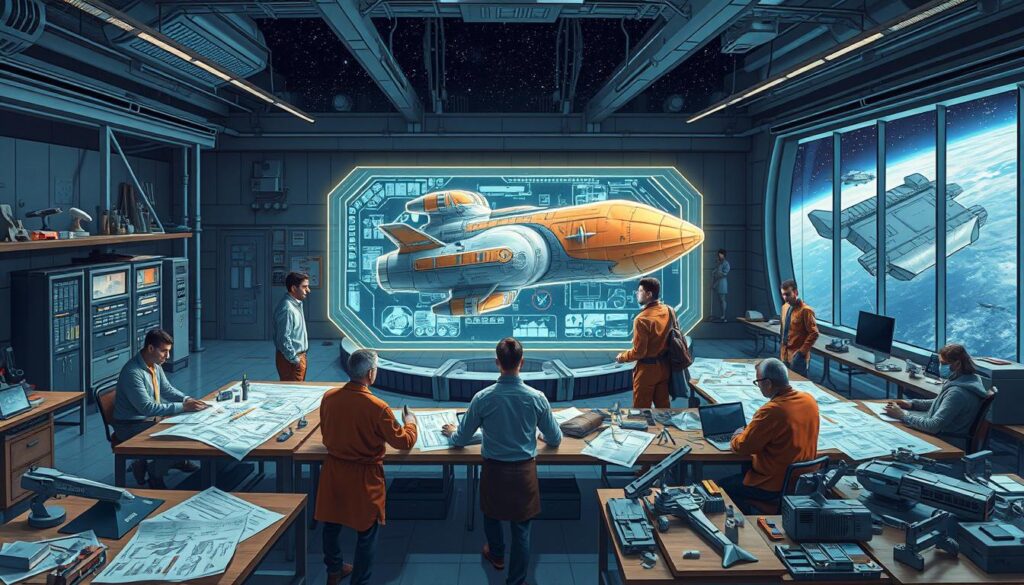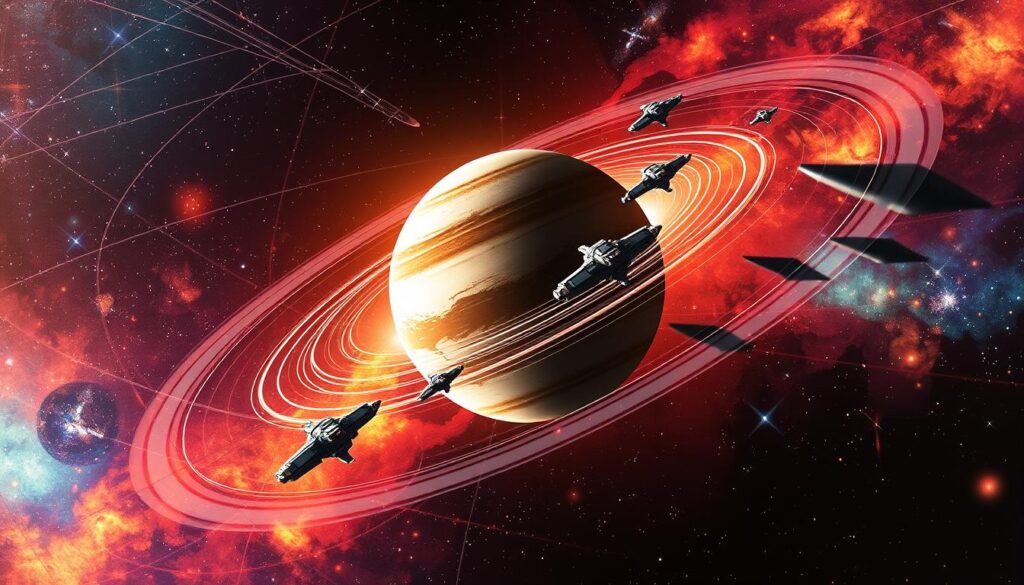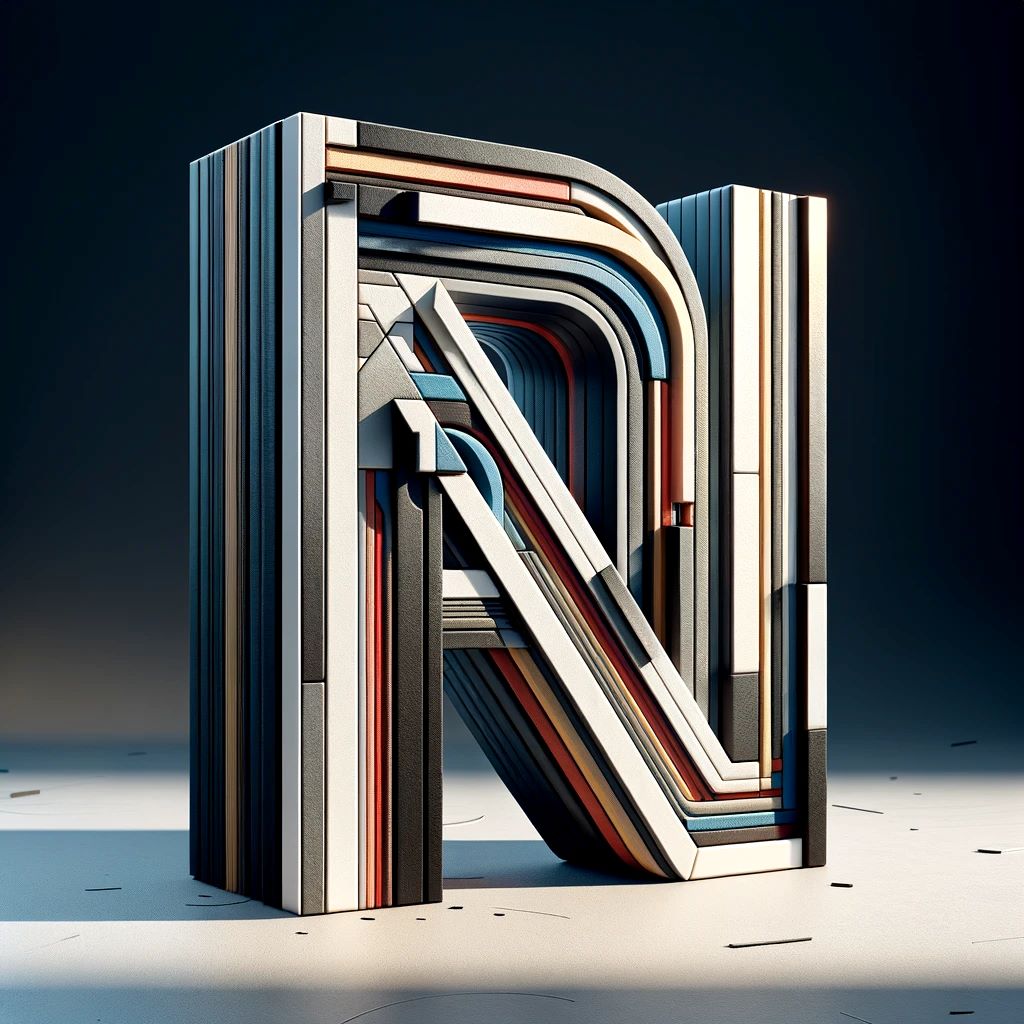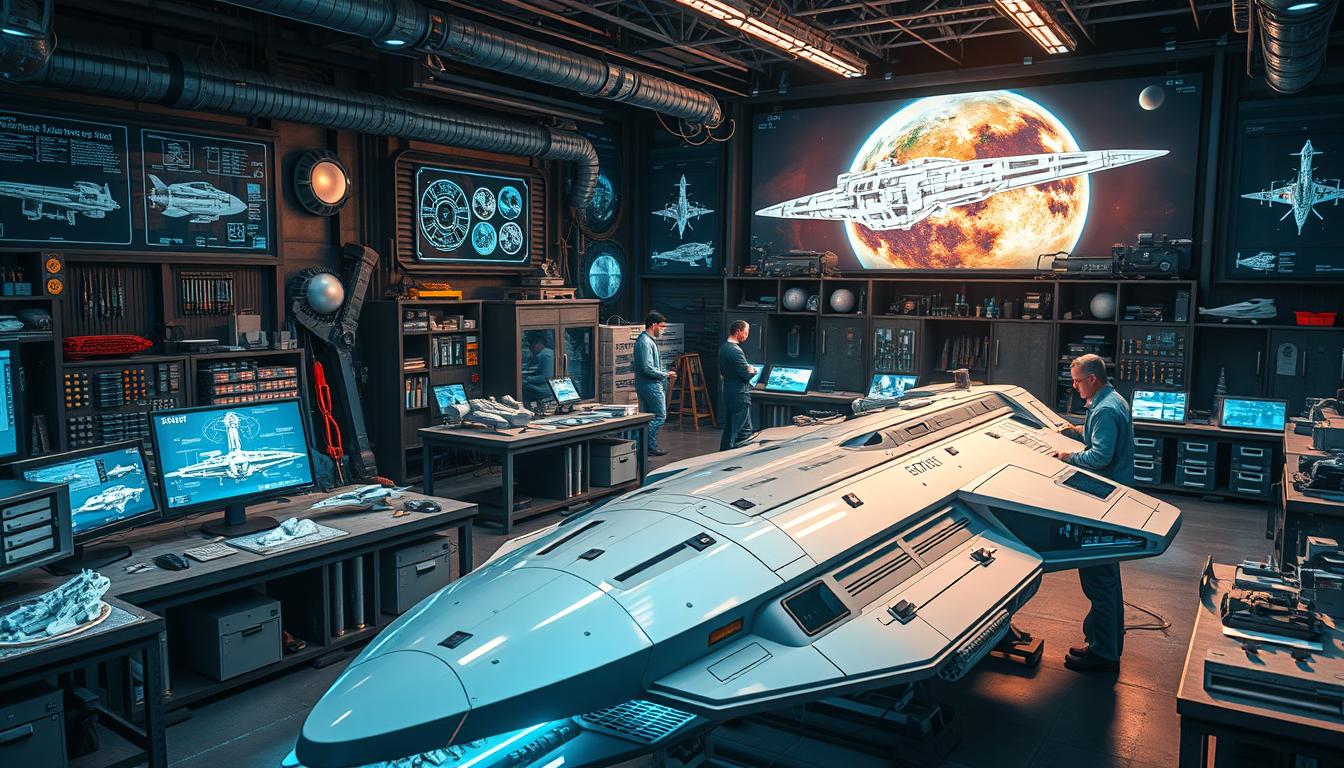“As an Amazon Associate I earn from qualifying purchases.” .
Looking up at the stars fills us with wonder and possibility. Space has always sparked our imagination, driving us to explore beyond our planet. This urge has led to spacecraft engineering, making our dreams of space travel real. We’re no longer just observers; we’re creators and explorers of the cosmos.
Our journey in space technology shows our endless creativity. From the first satellite to the latest Mars rovers, each step has been a giant leap for humanity. Spacecraft engineering blends science and innovation, letting us explore new frontiers.
Space exploration comes with huge challenges. NASA’s Orion spacecraft must handle temperatures of 5000 degrees when coming back to Earth. These challenges inspire us. Aerospace engineers are now helping NASA design new suits for missions to the moon and Mars.
Looking ahead, the future is full of possibilities. NASA plans to build the Gateway, a space station near the moon, to help us reach Mars. The Aerospace Corporation is growing and winning big contracts to support these big goals.
From Viking 1’s Mars landing in 1976 to the Hubble Space Telescope’s discoveries, space tech has expanded our knowledge. Spacecraft engineering offers many exciting jobs, from engineers to managers, all working to uncover the universe’s secrets.
Key Takeaways
- Spacecraft engineering turns space exploration dreams into reality
- NASA’s Orion spacecraft faces extreme temperatures during re-entry
- The Gateway space station is planned as a stepping stone to Mars
- Aerospace Corporation is expanding to support space exploration efforts
- Career opportunities in spacecraft engineering are diverse and growing
- Space technology continues to advance, from CubeSats to ion propulsion systems
Introduction to Spacecraft Engineering
Spacecraft engineering is a thrilling field that leads the way in space exploration and tech innovation. We design and build the machines that go into space. Our work includes everything from launch vehicles to complex spacecraft designs.
Defining Spacecraft Engineering
Creating vehicles that can go beyond Earth’s atmosphere is what spacecraft engineering is all about. We combine different fields to make these amazing technologies. We focus on aerodynamics, propulsion, and materials science.
Historical Milestones in Space Exploration
The history of space exploration is filled with amazing achievements. From the first human spaceflight to walking on the Moon, each step has expanded our knowledge. These moments have shaped our view of the universe and inspired many engineers.
“One small step for man, one giant leap for mankind.” – Neil Armstrong
The Importance of Space Technology
Space technology is crucial in our daily lives. It helps with global communication, weather forecasts, and scientific discoveries. The aerospace industry has many jobs, from engineers to teachers, all working to improve space exploration.
| Aspect | Impact |
|---|---|
| Employment | Wide range of jobs in private industry, government labs, and R&D facilities |
| Education | Engineers often transition into teaching roles |
| Skills Required | Multidisciplinary knowledge including fluid dynamics, structures, electronics |
| Technology | Proficiency in MATLAB, C++, FORTRAN, and Python |
As we keep exploring space, the need for new spacecraft designs and launch vehicles increases. The future of space tech is full of exciting developments and new discoveries to make.
Fundamentals of Spacecraft Design
Spacecraft design is a complex field that requires knowledge in many engineering areas. We mix aeronautical and astronautical engineering to make vehicles that can handle space’s tough conditions. Our focus on structural design makes sure the spacecraft can take the forces of launch and re-entry.
Mission planning is key to figuring out what each spacecraft needs. We look at propulsion systems, thermal protection, and radiation shielding to make sure the spacecraft works well and stays safe. The design also includes making ground control procedures and managing operations.

Many professionals learn about spacecraft design by taking special courses. These courses give them deep insights into space exploration and how to design spacecraft.
| Course Aspect | Details |
|---|---|
| Duration | 2-4 days |
| Target Audience | Aerospace engineers, mechanical engineers, project managers, scientists |
| Key Topics | Spacecraft components, structural requirements, materials, configuration, mission-specific design |
| Instructor Experience | 25+ years in aerospace, 10 patents |
| Practical Focus | Fabrication, cost estimation, testing, failure analysis |
These courses give engineers the knowledge and skills they need for spacecraft design projects. By mixing theory with practical exercises, we get the next generation of space engineers ready for future missions.
Propulsion Systems in Space Technology
Exploring the cosmos is made possible by propulsion systems. These systems help spacecraft escape Earth’s gravity and travel through space. Let’s explore how space propulsion helps us journey among the stars.
Chemical Propulsion
Chemical propulsion is key for launch vehicles and the early stages of space travel. It uses chemical reactions to create thrust. We see it in action with rockets like the Saturn V and today’s launchers.
Electric Propulsion
Electric propulsion is great for long missions. Ion engines and Hall-effect thrusters are efficient and perfect for deep space. They don’t have as much thrust as chemical rockets but can keep going for a long time. This lets spacecraft reach far-off planets.
Nuclear Propulsion
Nuclear propulsion could be the future of space travel. It offers high efficiency and could change how we explore space. But, it’s still facing challenges in technology and safety.
| Propulsion Type | Thrust | Efficiency | Best Use |
|---|---|---|---|
| Chemical | High | Low | Launch, initial stages |
| Electric | Low | High | Deep space missions |
| Nuclear | Medium | Very High | Future interplanetary travel |
As we explore space technology, propulsion systems are getting better. From powerful chemical rockets to efficient electric thrusters and promising nuclear propulsion, these innovations help us explore the universe. The push for better propulsion methods is exciting, offering new possibilities for space missions.
Orbital Mechanics and Mission Planning
Orbital mechanics and mission planning are key to space exploration. They help us plan our trips beyond Earth. Let’s explore how they shape our space missions.

Orbital mechanics deals with how objects move in space. It’s crucial for planning space missions. We use math to figure out paths for missions like the Apollo program and satellites.
Mission planning is also very important. It means picking the best time to launch, figuring out fuel needs, and planning the best path. These steps help make space missions successful and expand our exploration.
| Component | Grading Weight |
|---|---|
| Examination I | 20% |
| Examination II | 20% |
| Mission Planning Project | 25% |
| Comprehensive Final Examination | 35% |
Our course goes deep into orbital mechanics and planning space missions. We look at history, special orbits, and more. The goal is to understand orbital mechanics and thrusting for future missions.
Research in spaceflight mechanics focuses on designing paths, optimizing, and simulating. These areas help us improve space exploration and push orbital mechanics limits.
“Space is for everybody. It’s not just for a few people in science or math, or for a select group of astronauts. That’s our new frontier out there, and it’s everybody’s business.”
As we keep exploring space, orbital mechanics and good mission planning will lead us to new discoveries. They’ll help us unlock the secrets of the universe.
Spacecraft Engineering: Structural Design and Materials
In spacecraft engineering, making vehicles strong for space is key. We use advanced materials and new methods for this. Our goal is to make structures that are both light and strong.
Lightweight Materials in Spacecraft Construction
The aerospace world loves composite materials for building things. Graphite/epoxy composites are top picks because they’re strong but don’t weigh much. For example, the MSX spacecraft uses a special graphite/epoxy structure that stays stable in heat.
Thermal Protection Systems
Keeping spacecraft safe from heat during entry into the atmosphere and keeping them at the right temperature in space is vital. The MSX spacecraft uses heat pipes to keep its temperature steady. It also has thick aluminum panels for extra support and to keep things cool.
Radiation Shielding
Keeping astronauts and important equipment safe from harmful space radiation is crucial. The MSX doesn’t share details on its radiation shielding, but most spacecraft use a mix of materials and designs to protect against radiation during long trips.
The MSX spacecraft is 5.1 meters long and weighs 2812 kg. It shows how important it is to combine structural design, thermal protection, and radiation shielding. It has 11 optical sensors in its instrument section, showing the need for careful control of the environment in space tech.
Avionics and Control Systems
Avionics systems are key to controlling modern spacecraft. They manage navigation, communication, and flight. Engineers have made big strides in this area, helping with space missions that explore the universe.
At the core of spacecraft control are its avionics. These systems use the latest electronics, sensors, and software. They keep track of the spacecraft’s position, path, and goals. As we go further into space, having reliable avionics is more important than ever.
Planning a mission depends a lot on advanced avionics. These systems work on their own, especially in deep space where talking to Earth is hard. They need special skills and knowledge.
“Avionics is the brain and nervous system of aircraft and spacecraft, integrating diverse systems into a cohesive, functional unit.”
Avionics engineering is a thrilling career. It pays an average of $64,310 as of 2019. Most employers want a certification from the National Center for Aerospace and Transportation Technologies (NCATT). This shows the high standards of the field.
To become an avionics engineer, you need a four-year degree in Electronic Engineering Technology with a focus on Avionics. You’ll learn about things like Aircraft Power and Distribution Systems, Flight Control Systems, and Radar Systems. This education gets you ready for jobs in designing, developing, and keeping spacecraft systems running smoothly.
Power Generation and Management in Space
In spacecraft engineering, power generation and management are key. We’ve made big steps in creating efficient power systems for space missions. From solar power to nuclear options, our tech keeps getting better.
Solar Power Systems
Solar power is top choice for Earth-orbiting spacecraft. Satellites use solar panels to turn sunlight into electricity. For missions far from Earth, like NASA’s Juno at Jupiter, bigger solar arrays are needed. Juno has three solar arrays, each 30 feet long!
Solar cells have evolved a lot. Now, we have triple junction cells, aiming for 4-6 junction cells for better efficiency. In Earth’s orbit, solar power makes about 1.4 kilowatts per square meter.
Nuclear Power for Deep Space Missions
For deep space missions, we use radioisotope power systems. These systems make electricity from heat from unstable atoms. They’ve powered trips to Saturn, Pluto, and even beyond our solar system!
NASA’s Voyager spacecraft, with radioisotope power, have been working for over 40 years. They still send data from deep space.
Energy Storage Solutions
Energy storage is crucial for steady power during eclipses or high demand. We’ve improved battery tech, making them smaller yet more powerful. Most satellites use secondary batteries when they’re in the shade of the Sun.
| Power System | Application | Efficiency |
|---|---|---|
| Solar Arrays | Earth orbiting satellites | Up to 30% |
| Radioisotope Power | Deep space missions | Long-lasting, constant power |
| Li-ion Batteries | Energy storage | High energy density |
We’re working on new battery tech like Lithium-Sulfur for more energy in space. We’re also making power electronics smaller and more efficient. This lets our spacecraft go further and last longer than ever.
Cutting-Edge Technologies in Spacecraft Engineering
Space technology is changing fast, bringing new ideas and ways to explore space. We’re seeing big steps forward in making spacecraft better and opening doors for new space travel.
Raytheon Intelligence & Space leads in these changes, making top-notch tech for air superiority. Their Distributed Aperture System (RDAS) gives unmanned and rotary platforms full view of their surroundings. The Common Open Secure Mission Computer (COSMC) works with many types of aircraft.
Artificial intelligence and machine learning are changing how we lead in the skies. These technologies help pilots by giving them data and making complex situations clearer. This use of AI/ML and digital twins speeds up tech progress and keeps us ahead in the air.
- Electronic warfare solutions, including high-power offensive systems
- Rapid adaptation of existing systems to maintain battlefield advantage
- Growth in commercial supersonic flight and space flight
- Rise in unmanned aircraft systems for recreational and commercial use
The Federal Aviation Administration is looking for aerospace engineers to ensure safety in launches and reentries. This need shows how innovation is creating new job chances in space tech and exploring the future.
Conclusion
Looking back, we’re amazed at how far spacecraft engineering has taken us. From the Wright brothers’ first flight to SpaceX’s reusable rockets, our drive to explore space has never stopped. The aerospace industry is expected to grow by 6% from 2022 to 2032, showing its bright future.
Our progress in technology has brought us closer to amazing goals. We’re not just dreaming of going to Mars; we’re making it happen. Aerospace engineering offers great careers with median salaries of $126,880 for those eager to expand human knowledge.
Looking up at the stars, we see a future full of hope. Space tourism, sustainable aviation, and even mining in space are becoming real. This is all thanks to aerospace engineers’ hard work. Our space journey is just starting, and the best is yet to come.
FAQ
What is spacecraft engineering?
What are some historical milestones in space exploration?
Why is spacecraft design a multidisciplinary approach?
What are the different types of propulsion systems used in spacecraft engineering?
What is the importance of orbital mechanics in spacecraft engineering?
What materials are used in spacecraft structural design?
What role do avionics and control systems play in spacecraft engineering?
How is power generated and managed in spacecraft?
What are some cutting-edge technologies in spacecraft engineering?
“As an Amazon Associate I earn from qualifying purchases.” .



